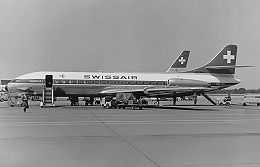Swissair Flight 306
|
Swissair's HB-ICX, sister aircraft to the aircraft HB-ICV lost in the accident. | |
| Accident summary | |
|---|---|
| Date | September 4, 1963 |
| Summary | In-flight fire leading to hydraulic failure and loss of control |
| Site |
near Dürrenäsch, Switzerland 47°19′N 8°09′E / 47.317°N 8.150°ECoordinates: 47°19′N 8°09′E / 47.317°N 8.150°E |
| Passengers | 74 |
| Crew | 6 |
| Fatalities | 80 (all) |
| Aircraft type | Sud Aviation SE-210 Caravelle III |
| Aircraft name | Schaffhausen |
| Operator | Swissair |
| Registration | HB-ICV |
| Flight origin | Zurich Airport |
| Stopover | Geneva International Airport |
| Destination | Fiumicino Airport |
Swissair Flight SR306, a Sud Aviation SE-210 Caravelle III, named Schaffhausen, was a scheduled international flight from Zürich to Rome, via Geneva. It crashed near Dürrenäsch, Aargau, on September 4, 1963, shortly after take-off, killing all 80 people on board.[1]
Take off and flight
Zurich Airport was in dense fog when the plane was due to take off at 06:00 UTC. At 06:04 the flight was allowed to taxi to runway 34 behind an escorting vehicle. At 06:05 the crew reported that they would taxi halfway down runway 34 to inspect the fog and then return to the take off point. This was done using high engine power in order to disperse the fog. Around 06:12 the aircraft returned to runway 34 and was allowed to take off, which it did 06:13, and started to climb to flight level 150, its cruising height.
Four minutes later people on the ground noticed a white trail of smoke coming from the left side of the aircraft. Shortly after, a long flame erupted from the left wing. Around 06:20 the aircraft reached a height of about 2700 m. It then began to descend, entering a gentle left turn before losing height more quickly. It then went into a final, steep dive.
At 06:21 a MAYDAY message was issued. At 06:22 the aircraft crashed into the ground on the outskirts of Dürrenäsch, approximately 35 km from Zürich Airport.[2]
Probable cause
The aircraft's brakes overheated due to the application of full engine power during taxiing. This caused the aluminum wheels to burst, one of them on the runway prior to departure. Upon retraction of the landing gear, the hydraulic lines in the gear bay were damaged. This was caused either by the wheels that had exploded, or the bursting of the other wheel rims during the climb. Subsequently, spilled hydraulic fluid ignited when it came in contact with the overheated landing gear rims. The fire damaged the gear bay, followed by the wing. Finally losing its hydraulic pressure, the aircraft became impossible to control. The cabin and the cockpit were filled with smoke, adding to the predicament of the crew. Control of the aircraft was lost totally at around 06:18, and the ensuing final dive and impact destroyed the aircraft.[1]
Result
As a result of this accident, all Caravelles were modified to use non-flammable hydraulic fluids.[2]
Casualties and aftermath
This crash had some severe effects for a small village in the Canton of Zürich. 43 people from Humlikon boarded the plane to visit a farm test site near Geneva. Among these were:
- 19 married couples (who had a total of 39 children aged between 3½ and 24 years that were orphaned).
- 1 mother of 3 minors
- 1 father of 2 minors
- 1 father of 2 adults
- 2 single men.
The village lost one fifth of its population of 217 in the crash. The entire local council, the people who took care of the schools, and the post office clerk perished. Most orphans were looked after at home by relatives. Six children had to move, all but one of whom went to live with relatives nearby. Just over a month after the crash, a new council was elected by the remaining 52 people entitled to vote.
A further problem was the upkeep of the local farms, but people from the nearby villages helped. Apprentices came from local firms, students, firemen, soldiers, boy scouts, railroad workers and policemen, as well as volunteer school children. People also came from abroad to help. 600 tons of potatoes was harvested manually. Corn was threshed and the new crop seeds were sown in time.[3]
See also
- Nigeria Airways Flight 2120 – a 1991 crash caused by a similar landing gear fire
- Air France Flight 4590 – a 2000 crash caused by an inflight fire triggered by tire burst on takeoff
References
- ↑ 1.0 1.1 "Swissair 306 air crash". Pilotfriend.com. Retrieved 2 January 2013.
- ↑ 2.0 2.1 "Swissair HB-ICV – 4. September 1963". Sud Aviation. Retrieved 2 January 2013.
- ↑ "Der Flugzeugabsturz in Dürrenäsch 1963" (in German). Humlikon.net. Retrieved 2 January 2013.
Further reading
- Job, Macarthur (1994). "Chapter 3:"...Taxi onto the runway...to have a look around...?"". Air Disaster:Volume 1. Aerospace Publications. pp. 30–36. ISBN 1875671110.
| ||||||||||
